Any Woman who has had children can tell you that the body you once knew becomes a land of discoveries after birth. You experience a lot of changes, some that stay and some that are temporary. Many are hormone induced while others are simply because you just created life.
* This post includes some affiliate links. This means that any product purchased from my links will generate a small commission (At no extra cost to you). As always, I will only recommend brands that have passed my seal of approval and that I truly love.. these commissions help to cover Bloom + Clementine’s fees so that this website can stay alive and I can continue sharing my green beauty passion with you all. Thank you for supporting my little green space on the internet. *
One major outward change that occurred for me was that my skin type changed dramatically. Prior to babies I was redness and acne prone, these days I’m much less sensitive with major dehydration and deepening lines. While the aging process has certainly excelerated purely from the stress and worry that comes with Motherhood, most of the immediate lines seen postpartum are due to dehydrated skin that are highlighting lines already present. This effect is compounded by breastfeeding which dehydrates you further.
So with that, I will start with dehydration and irritation.
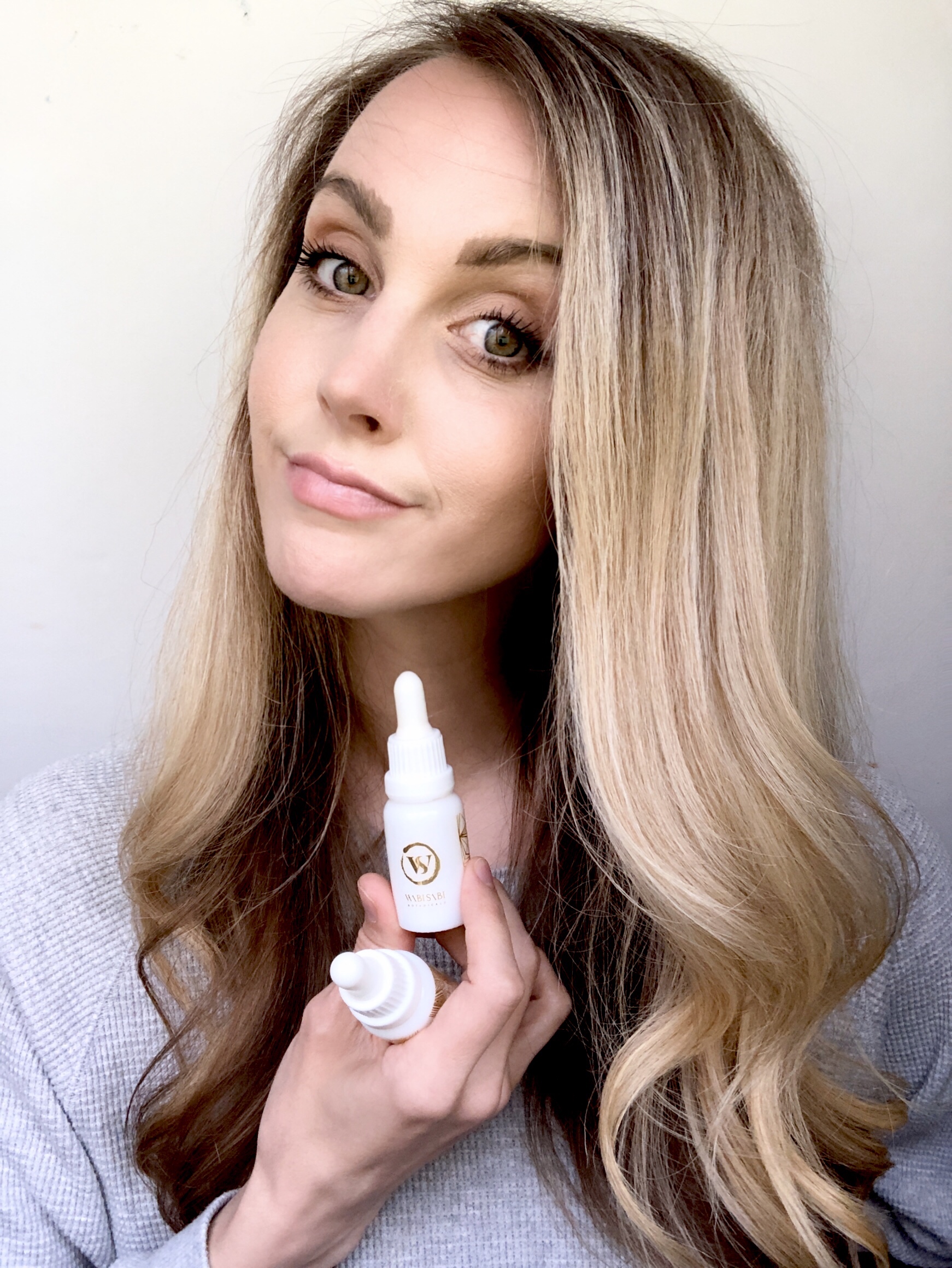
Skin Concern 1: Dryness/Irritation
Dryness and Irritation go hand in hand. We all know that our skin shrinks, scales, and can even become itchy when water loss is present. Hormones are a major player in many postpartum skin conditions and this is also true of dehydration, but Women are handed an extra layer of dryness while breastfeeding is at play. I am a major advocate of breastfeeding for the health of both Mom and Baby, but as you would imagine, making food from scratch for your baby while also trying to keep yourself nourished can have its challenges. Your first plan of attack when nursing is to up your intake of water. Our insides are reflected by our outsides and your body is going to give all the good stuff to baby first, so you need to top yourself up to manage enough liquids for both of you. The first signs of Mama not getting enough water typically shows in the skin as the body will use it for essential areas such as organs first. You can also eat more water containing foods like (ie. cucumber or watermelons) to hit the correct daily amount.
“Hydration while breastfeeding should follow the commonsense “in and out” principles of hydration: If you use more fluid, you must take more in. Since the average six-month-old consumes around 1 quart of breast milk daily and 90 percent of that milk is water, it stands to reason that mother should drink four extra 8-ounce glasses of fluid daily.” -Dr. Sears (www.askdrsears.com)
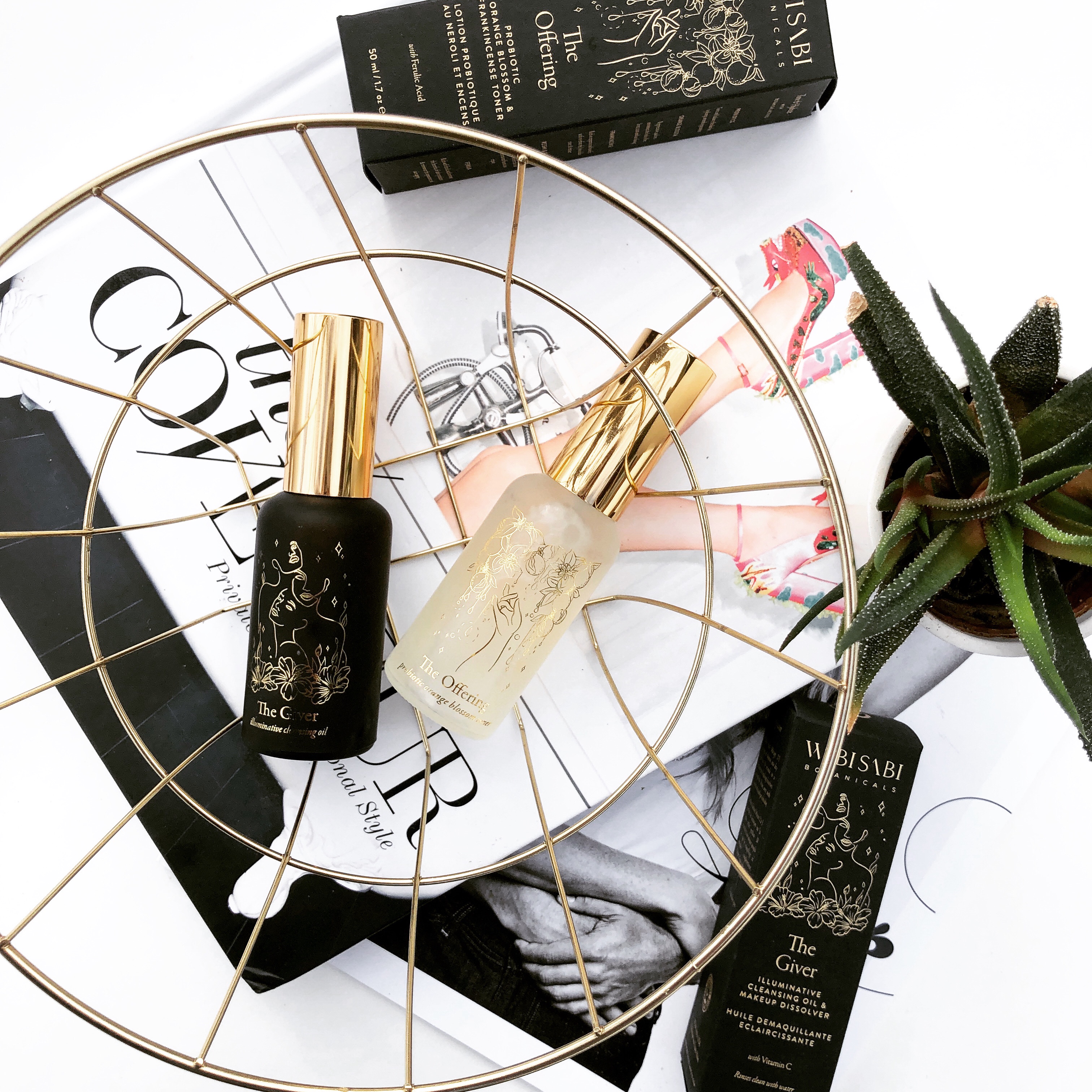
After ensuring adequate internal intake of water, you need to refeed your skin with proper skincare from the outside too. I like to think of skincare as my skins food as the outside also requires nourishment. Finding products that target dehydration and moisture is imperative.
• Up your intake of water (especially if breastfeeding)
• Opt for a Cleansing Oil over traditional face wash
• Use a Hydrosol for hydration
• Apply Targeted nourishing and well sourced oils to combat dehydration in the outer level.
• Use a toning mist between cleansing and application of oils/creams/balms. Keeping the skin wet allows product to penetrate and work at deeper levels rather than just sitting on the outer layer of your skin unabsorbed.
• Consider adding Ceramides to your routine
• Talk to you care provider about taking an omega fatty rich supplement to help increase internal hydration.
One line of products that I truly love and recommend wholeheartedly is Wabi Sabi Botanicals. This skincare includes a rinsable cleansing oil, a probiotic rich toning mist, my favourite face mask, and a handful of facial serums designed to specifically target certain skin types and ailments.
Since this skincare line is so well tolerated and works to gently yet effectively target many skin types and conditions, I will be highlighting which products from the line work on each postpartum skin condition I am discussing.
Starting with..
3 Step Regimen with Moisture Boost Serum
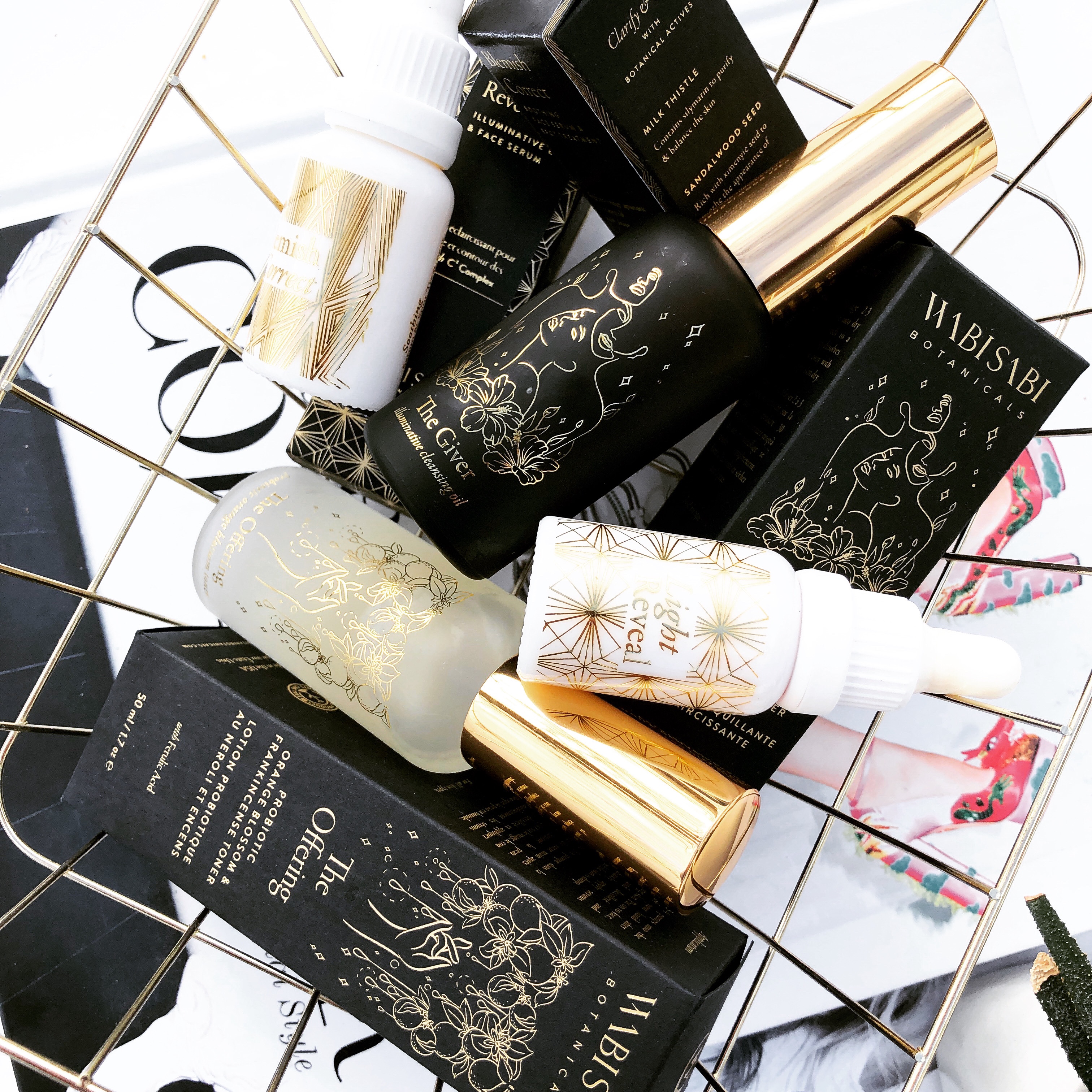
If dryness and irritation is your concern then their 3 step regimen would be a good fit. This includes their cleansing oil, toning mist and I would recommend the Moisture Boost skin serum. Not only does it have ingredients that works toward replenishing hydration, but they also contain ingredients like squalane for inflammation and Japanese umi budo oil to target deepening lines and graceful aging.
“This ultra-moisturizing blend of nourishing fatty acids and Amaranth Squalane works to repair and rescue dry skin. The rich yet fast-absorbing oil is infused with Ximenia, Sake, and Japanese Umi Budo algae to guard against chronic or seasonal dryness and leave skin soft, smooth and hydrated even in extreme weather.” – re: moisture boost serum www.Wabisabibotanials.com
Full Ingredient Deck (Moisture Boost):
Oryza Sativa (RICE BRAN) Oil, Ximenia Americana (XIMENIA) Oil*, Adansonia Digitata (BAOBAB) Seed Oil*, Squalane (AMARANTH-DERIVED SQUALANE), Bertholletia Excelsa (BRAZIL) Nut Oil*, Caulerpa Lentillifera (JAPANESE UMI BUDO) Oil*, Helianthus Annuus (SUNFLOWER) Seed Oil* and Rice Ferment Filtrate (SAKE) Extract*, Non-GMO Mixed Tocopherols (SUNFLOWER-DERIVED VITAMIN E).
.
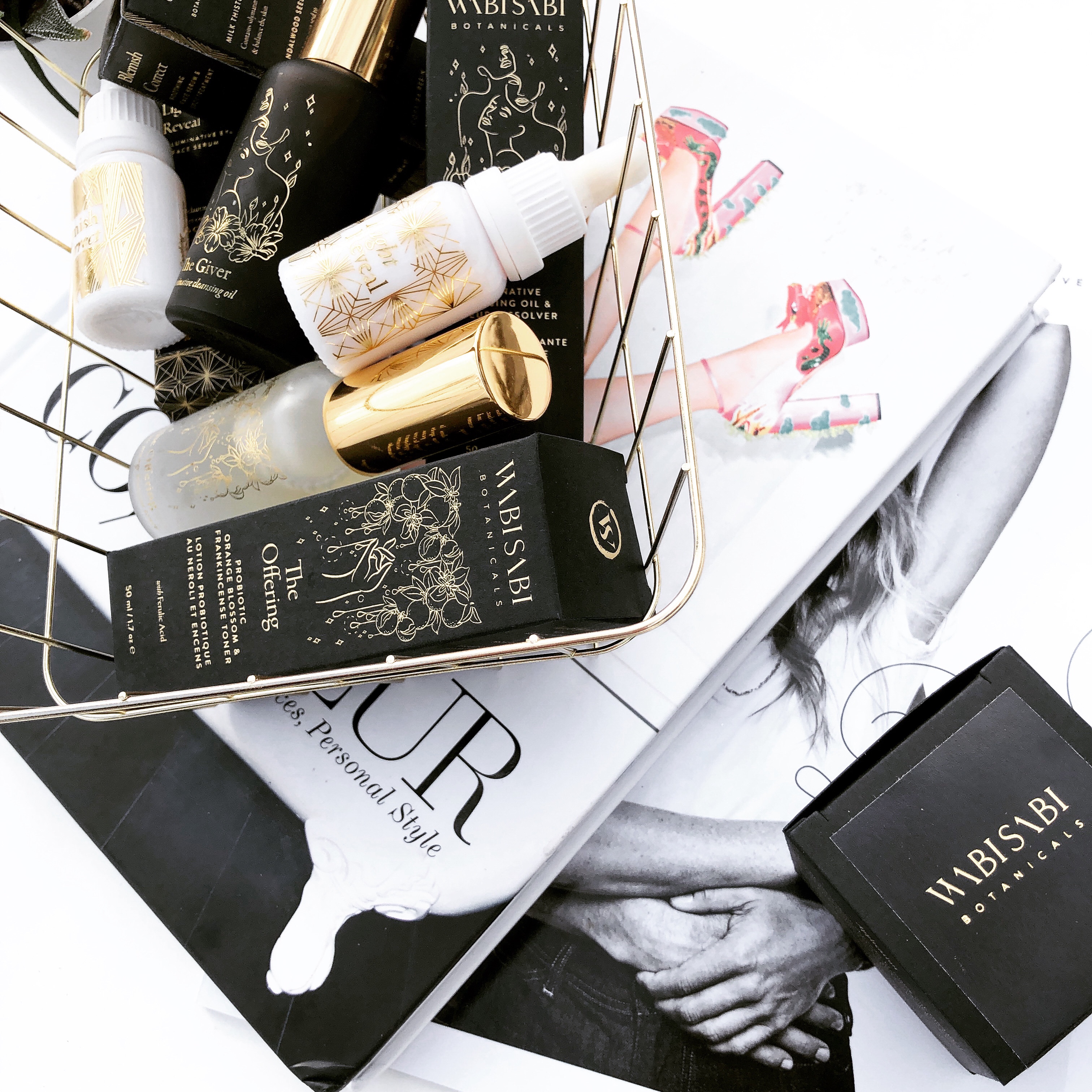
.
Skin Concern 2: Pigmentation/Melasma
Pigmentation is a condition that can affect a woman during both pregnancy and the postpartum period. Specifically, a condition most commonly experienced by women who are child bearing called Melasma is cited often. Melasma also affects those who take oral contraceptives and is thought to be strongly tied to hormones but also to genetics, sun exposure, and skin irritations. It is basically a patch of darkened skin that creates a mask like shape over the face. Melasma is only cosmetic in nature and does not cause any further symptoms or conditions. They can occur over any part of the face but most commonly occur within the centre of the face over the chin, lips, cheeks, nose and forehead.
One of the most promising and evident therapies in terms of treating Melasma naturally is by use of topical antioxidants. Two different ingredients were showing up in my search through different published articles, resveratol and astaxanthin. Of the two, astaxanthin is one of the worlds most powerful natural antioxidants protecting cells with success rates higher than even Vitamin E. Many use it for treating pesky sun damage. It can be taken both orally and topically, and even acts as a natural internal protectant from sun burns. This amazing antioxidant has been used for years now to treat hyperpigmentation and Melasma with great success.
It is a bright gem like colour of deep orange similar to the colour of Rosehip oil or sea buckthorn. It works in a few ways:
• protects the skin from oxidative stress and UV radiation while out in the sun
• Is protective from burning
• Creates faster cell turnover resulting in a lightening of spots and discolouration
• Is a natural skin lightener
Since it works on many levels, it is not only more effective but a quicker acting treatment than others.
Ways to avoid or help reduce & treat Melasma and hyperpigmentation:
• avoid too much sun exposure to affected areas. I am a huge advocate for sun exposure for immune support, however, if you are dealing with pigmentation issues like Melasma, you should be avoiding too much UV to that specific area. Use an all natural/physical blocking SPF or wear protective coverings like hats to minimize exposure.
• Promote faster skin cell turnover with weekly exfoliation.
• Use a topical form of antioxidant rich skin care (ie. astaxanthin)
Wabi Sabi Botanicals contains two products that I would recommend for managing skin conditions like Melasma and hyperpigmentation.
Valley of Light Face Mask
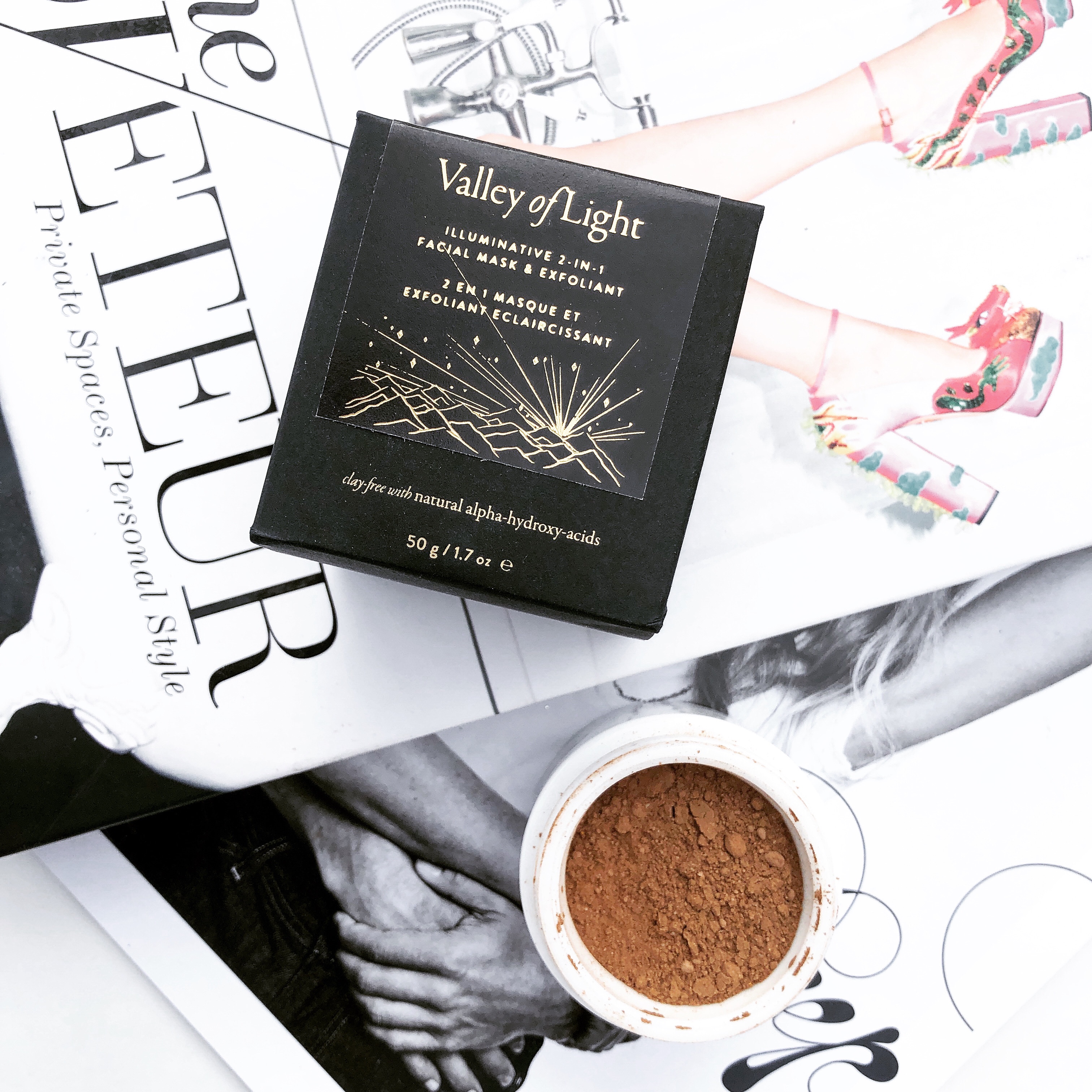
Their Valley of Light Mask is one of my very favourite face masks and it can be doubled as a physical exfoliant when washing off if you gently scrub with water in small circles. As mentioned above, the act of weekly exfoliation will help promote skin cell turnover resulting in a lightening of unwanted pigmentation.
“This 2-in-1 powder facial mask & brightening exfoliant with raw, volcanic Balinese Cacao and an adaptogenic Mushroom Complex boosts skin radiance and gives skin a smooth, plump appearance. This clay free blend has caffeine-rich Balinese Coffee and Guarana fruit and natural alpha-hydroxy-acids from Hibiscus that gently exfoliate and leave skin bright and even.” – re: Valley of Light Mask (www.wabisabibotanicals.com)
Full Ingredient Deck:
Theobroma Cacao (RAW VOLCANIC CACAO)*, Oryza Sativa (WHITE RICE)*, Hibiscus Sabdariffa (ROSELLE HIBISCUS)*, Coffea Arabica (BALINESE ARABICA COFFEE)*, Ganoderma Lucidum (FERMENTED REISHI)*, Cordyceps Militaris (CORDYCEPS)*, Inonotus Obliquus (CHAGA)*, Curcuma Xanthorrhiza (TEMULAWAK)*, Paullinia cupana (GUARANA)*.
*Organically grown / organique
Light Reveal Serum
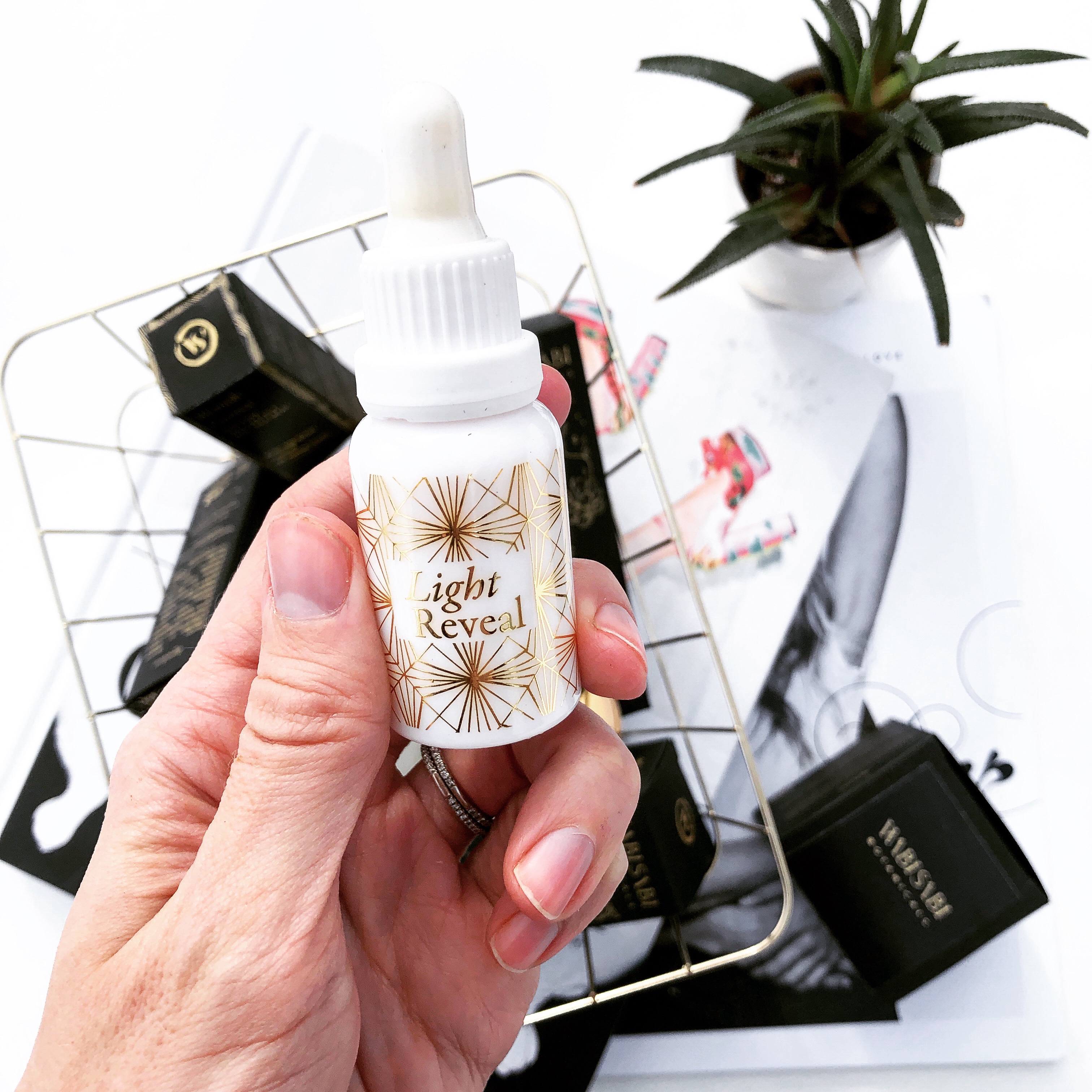
The second product that would target pigmentation concerns is their Light Reveal Serum. This is my FAVOURITE serum in the Wabi sabi line for so many reasons. It contains the powerful antioxidant, astaxanthin, which will help lighten darkened skin patches, promote cell turnover and protect the skin from further pigmentation. It smells so beautiful and is the most gorgeous marigold orange colour. I have personally used this serum over the last few years and have seen major improvement from past acne scarring. In addition to the astaxanthin, light reveal contains other targeted ingredients:
“This brightening eye and facial serum boosts skin radiance and evens skin tone and texture with botanical actives. The vibrant, fruity oil is infused with our C³ Complex – non-irritating vitamin C, natural carotenoids, and caffeine – to give skin a bright, smooth and even appearance.” – re: light reveal serum (www.wabisabibotanicals.com)
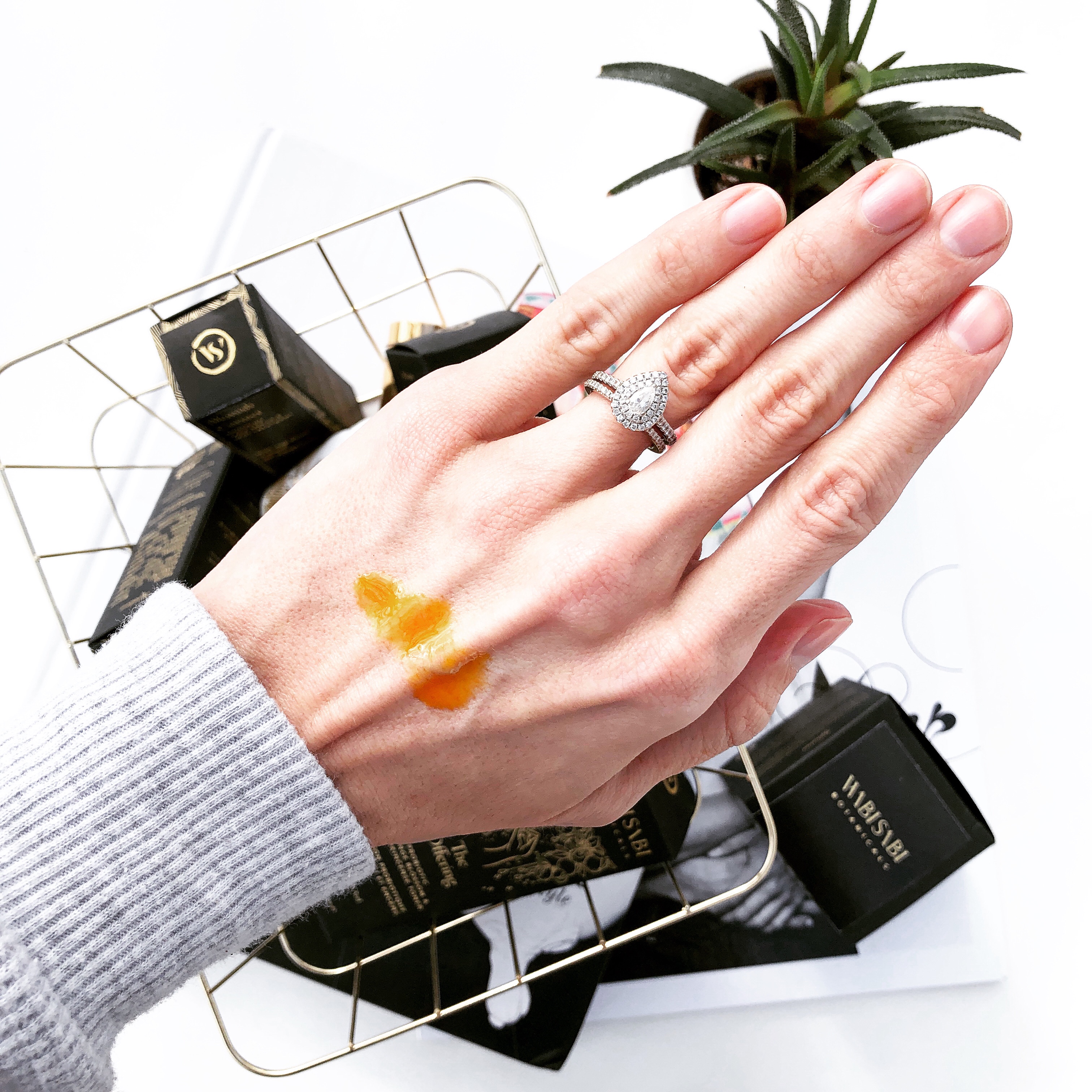
Full Ingredient Deck:
Aleurites Moluccan (CANDLENUT) Oil*, Caryocar Brasiliensis (PEQUI) Fruit Oil*, Carapa Guianensis (ANDIROBA) Oil*, Paullinia Cupana (GUARANA) Fruit Infusion*, Tetrahexyldecyl Ascorbate (VITAMIN C), Mauritia Flexuosa (BURITI) Oil*, Supercritical Hippophae Rhamnoides (SEA BUCKTHORN) Fruit Oil*, Non-GMO Tocopherols (SUNFLOWER-DERIVED VITAMIN E), Astaxanthin.
.
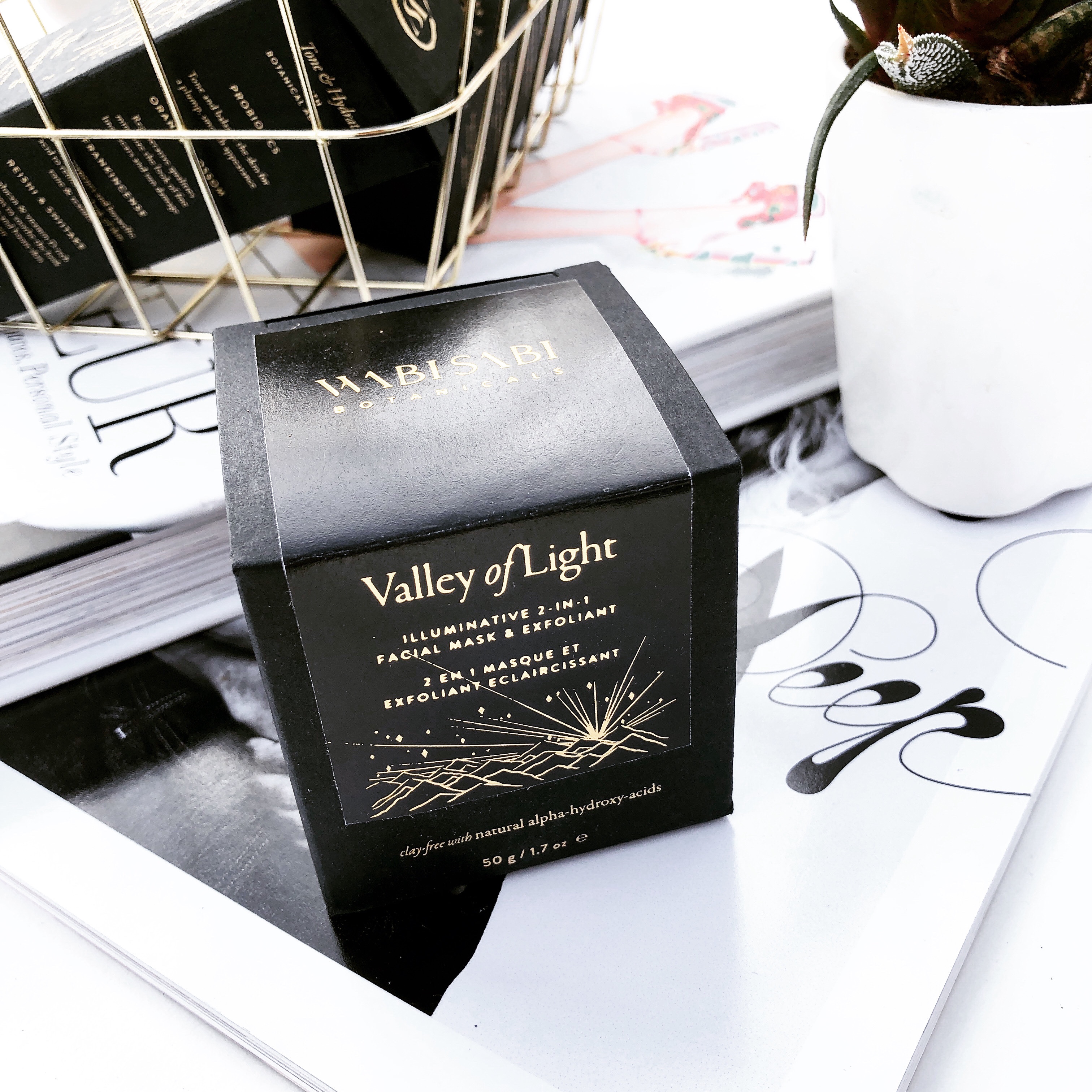
.
Skin Concern 3: Acne/Redness/Sensitivity
Acne is an ailment that I’ve dealt with personally and I fully understand how devastating it can feel to the person experiencing it. I experienced severe cystic acne in my early twenties from post birth Control syndrome. While I don’t experience acne or breakouts with pregnancy or postpartum, I certainly understand how aggravating the condition can be. As we all know, pregnancy and postpartum comes with extreme hormonal shifts which in some cases can affect acne breakouts. Your skin is also a major detox pathway and can shoulder the burden of other pathways that are not working at peak condition, such as the liver. I always suggest trying to improve diet and water intake to help internally but with postpartum acne it can be one or the other, or even both.
Another common culprit of acne breakouts is dry skin. When skin becomes dehydrated, the organ works to produce more sebum to make up for that deficit. In some, this results in over production and breakouts. The best way to balance this is by feeding your skin nourishing and healing oils. Resist the urge to “dry out the skin” with products that strip natural moisture barriers even further. This will anger your skin and cause further breakouts in a vicious cycle. When I was healing my own acne years ago, I found that adding simple topical oils into my regime was so beneficial. I avoided essential oils at this time as they irritate already inflamed skin. I also opted for oil cleansing over traditional cleansing. Oil cleansing is a practice that benefits so many skin conditions, ESPECIALLY acne.
• Drink more water (especially if breastfeeding)
• Avoid acne stimulating foods
• Avoid Fragrance, and Over Activating Ingredients
• Oil Cleansing over traditional cleansers to avoid stripping the skin
• Hydrosol/Face mist between cleansing and serum/oil/moisture/balm to ensure absorption
• Calming, nourishing, nutrient dense oils to moisturize which are targeted specifically for acne prone skin
• Consider supporting the liver by working with your care provider (ie. naturopath or FMD)
Wabi Sabi has products that contain gentle yet powerhouse ingredients and the main reason I love this line so much is that it’s dedicated to using no synthetics or fragrance. This is a major factor in treating acne prone skin as they are too activating and irritating. My personal recommendation to treating acne would be to use their 3 step program with Blemish Correct serum.
3 Step Regimen with Blemish Correct Serum
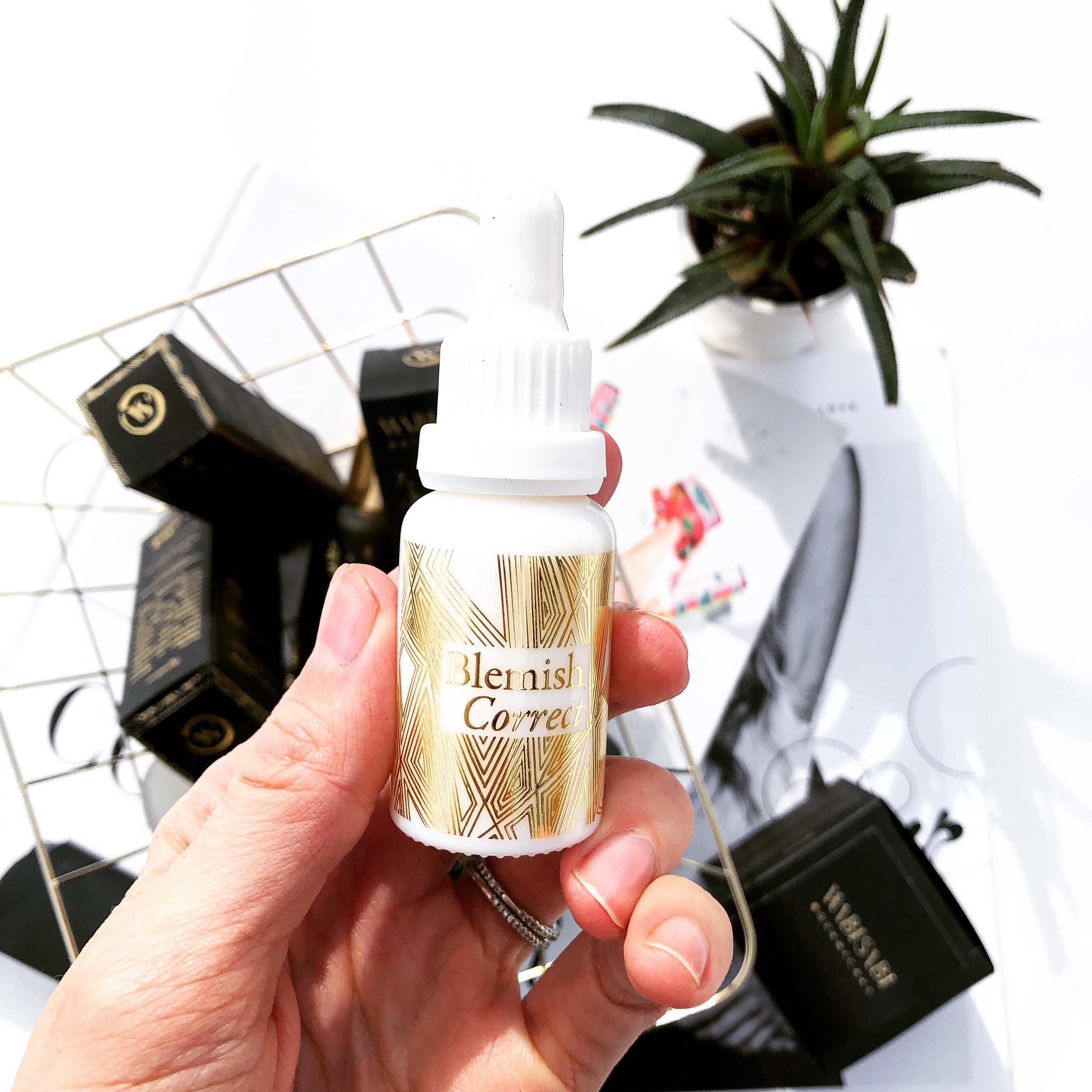
This contains their cleansing oil, probiotic rich toner and the blemish correct serum. As I mentioned above, a cleansing oil may seem counterintuitive and many are nervous to add oils to an acne fighting regimen but this is IMPERATIVE. We have been conditioned to think that stripping oils is the key to treating acne, but this couldn’t be further from the truth. We need to focus on NOURISHING the skin and BALANCING with nutrient rich products that will heal at a deeper level. Oil cleansing maintains natural oils, removes debris and makeup and nourishes the skin.
Next in the regimen is the probiotic rich face mist. This will help keep skin damp which is an important step before applying serums and moisturizers. It also helps these products absorb and work beneath the skin as opposed to just sitting on the surface with less action. Additionally, this toner is infused with probiotics which will feed good bacteria to the skin mantle. Your skin has its own microbiome, similarly to your gut, so by feeding this mantle you will create an environment strong enough to fend off any bad bacteria.
Lastly, the Blemish Correct Serum. This serum contains active ingredients targeted specifically for acne prone skin. It works to nourish and heal without creating further irritation. Ingredients like Milk Thistle Seed Oil work to purify the skin while others target redness and inflammation.
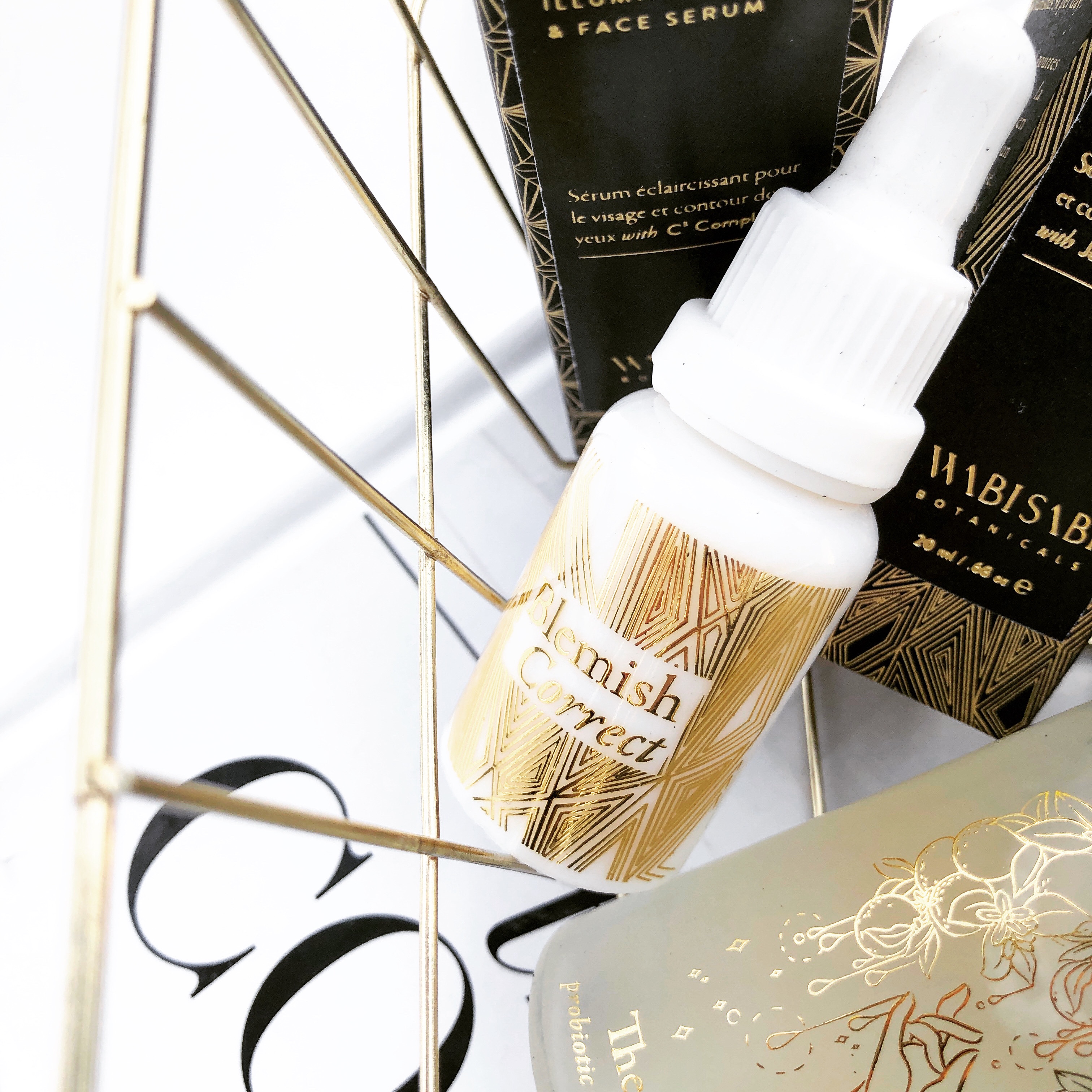
“This 2-in-1 calming facial oil and clarifying blemish treatment is enriched with botanical actives to reduce the look of redness and breakouts. This essential oil free blend is infused with skin-clearing Green Tea, inflammation-soothing Javanese Turmeric, natural terpene-rich Copaiba Resin, and more that support skin’s natural ability to heal and be radiant.” – Re: Blemish Correct Serum (www. Wabisabibotanicals.com)
Full Ingredient Deck:
Silybum Marianum (MILK THISTLE) Seed Oil*, Supercritical Santalum Spicatum (SANDALWOOD) Seed Oil*, Brassica Alba (WHITE MUSTARD) Seed Oil*, Helianthus Annuus (SUNFLOWER) Seed Oil and Camellia Sinensis (GREEN TEA) Leaf Extract*, Copaifera Officinalis (COPAIBA) Resin Oil*, Supercritical Curcuma Xanthorrhiza (TEMULAWAK) Root Oil*, Non-GMO Mixed Tocopherols (SUNFLOWER-DERIVED VITAMIN E).
.
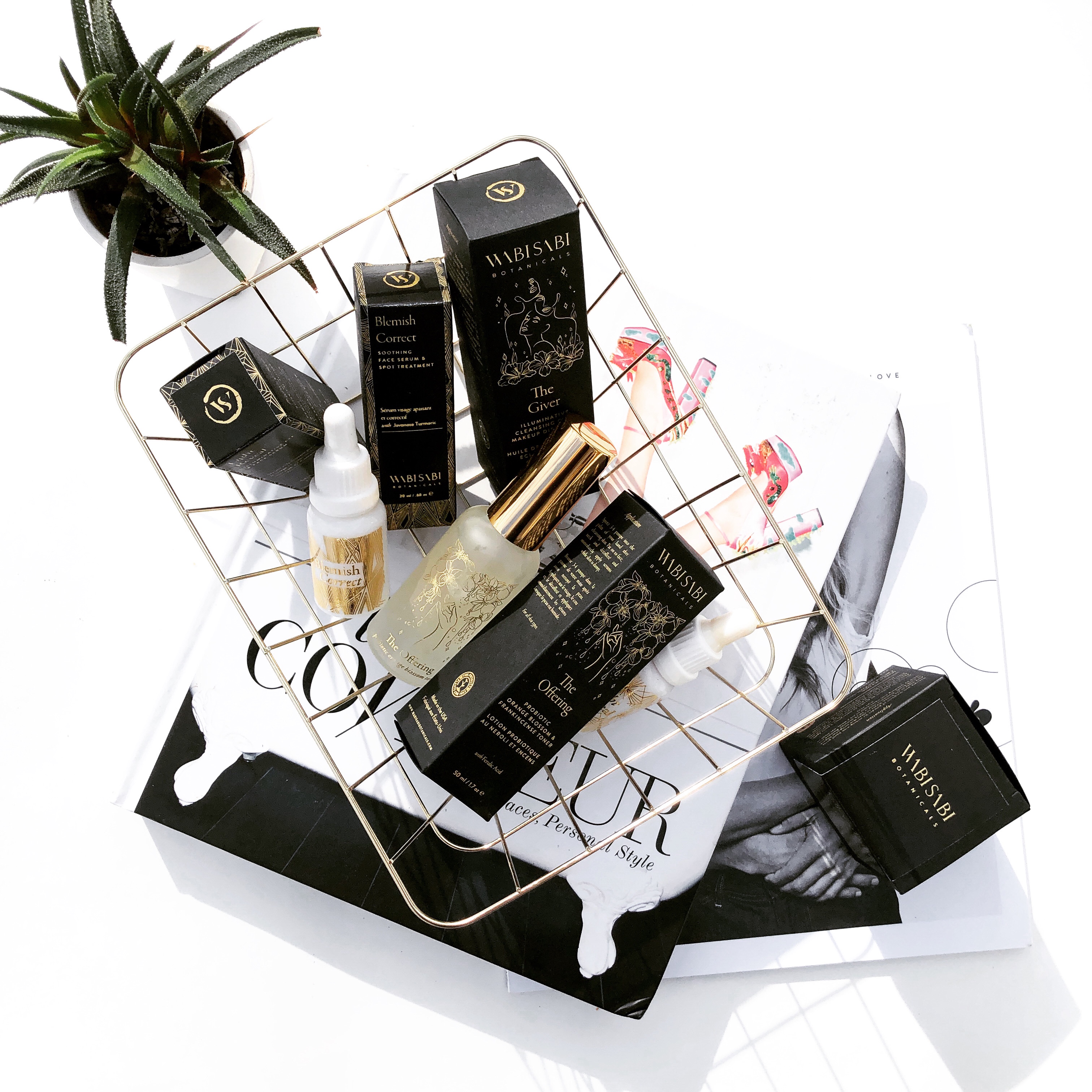
.
Wabi Sabi Botanicals
These 3 skin conditions (dryness/irritation, pigmentation/Melasma, acne) are of the most common postpartum skin conditions that occur. They are typically fleeting with this season of Motherhood but these tips will help you reduce or treat naturally so it doesn’t add extra stress to this time of your life. Remember there are always internal factors at play so consulting a naturopath or functional medical doctor can help. I recommend the Wabi Sabi Botanical’s Line specifically for skin conditions because they are natural, safe, added fragrance free, well sourced and incredibly effective.
You can have a look at their entire line on their website HERE. Elysse, the owner, is always happy to answer questions and help you target your skin care regime.
* This post was sponsored by Wabi Sabi Botanicals, as always, my opinions are my own *
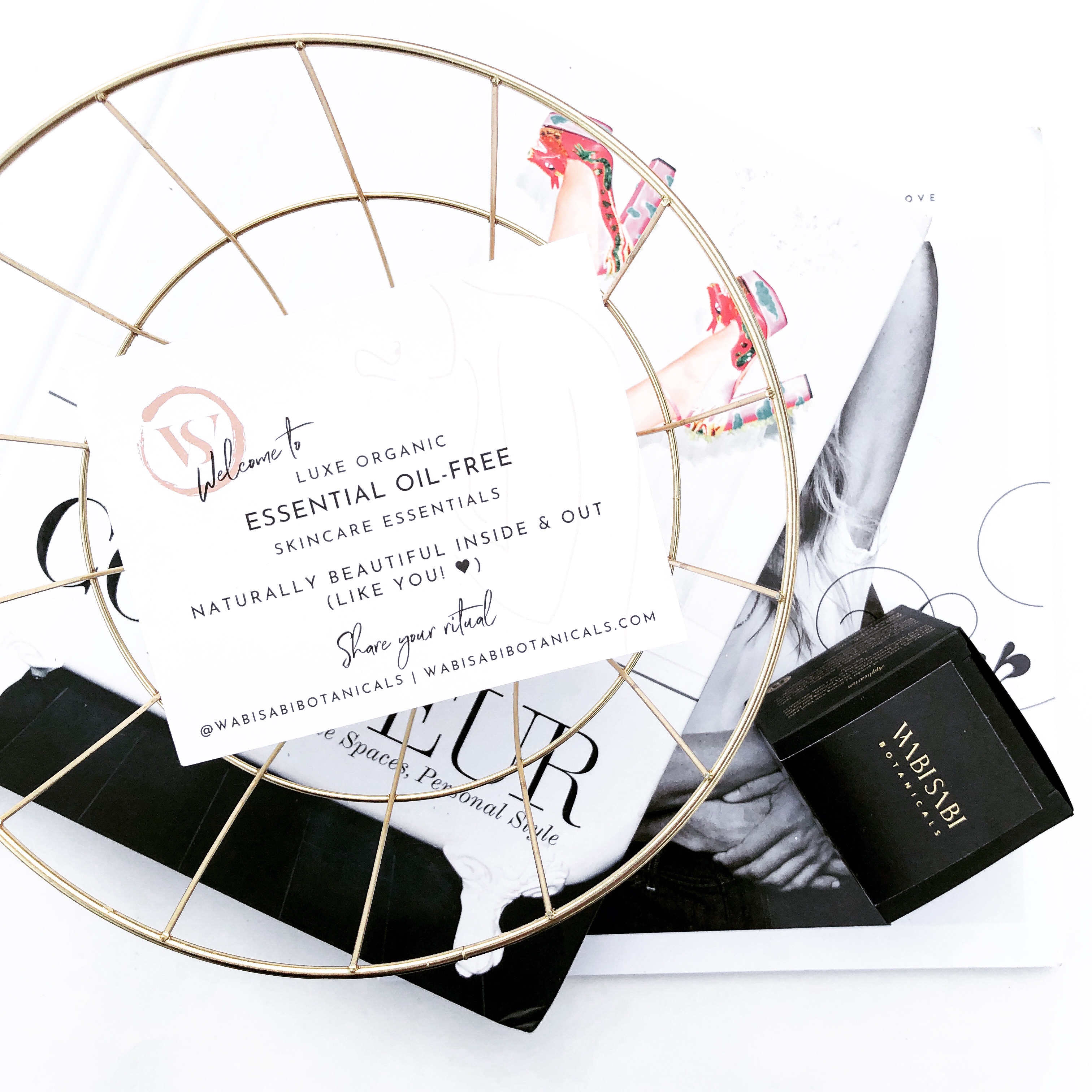

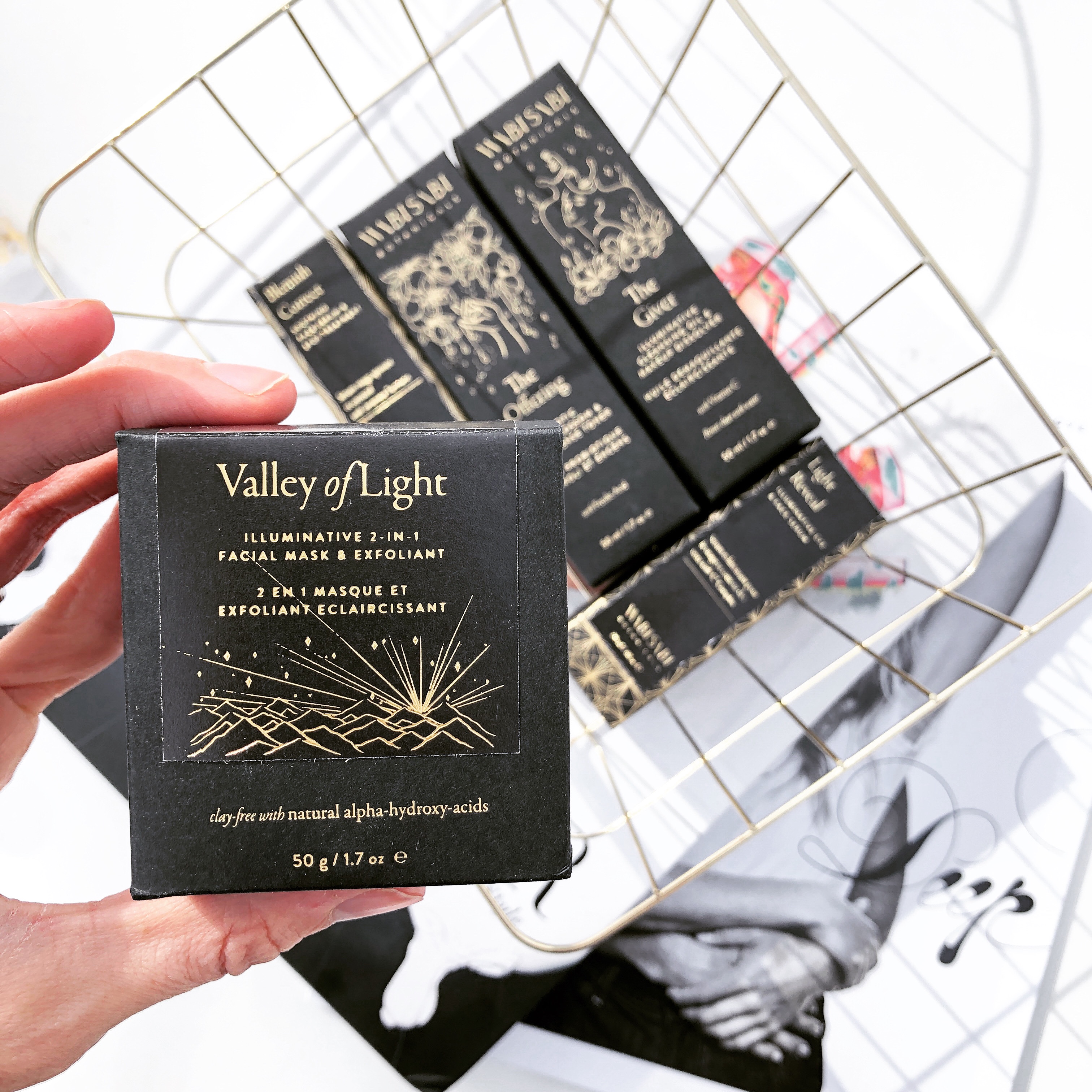
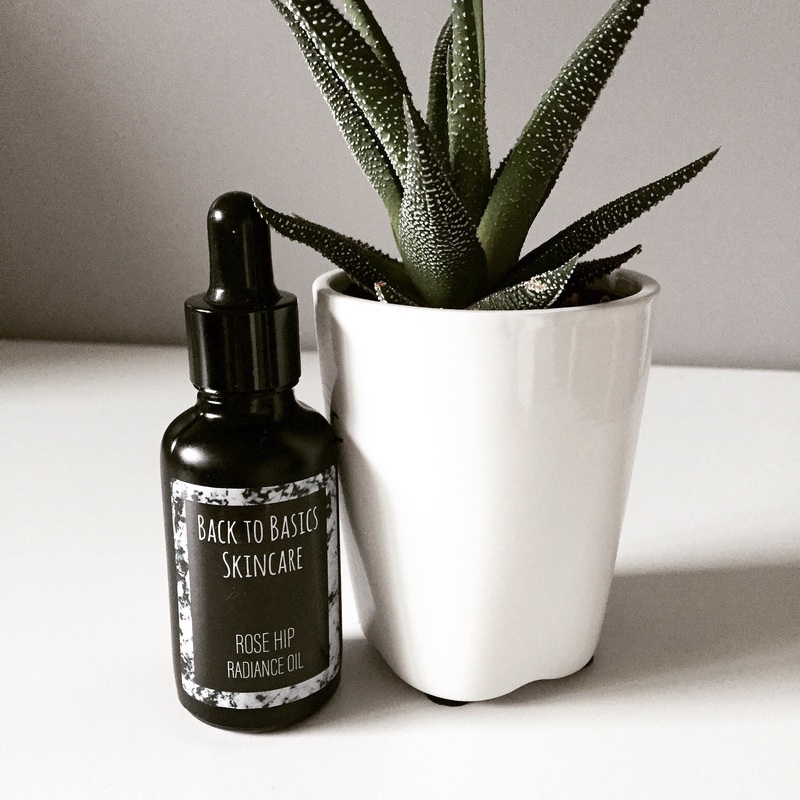
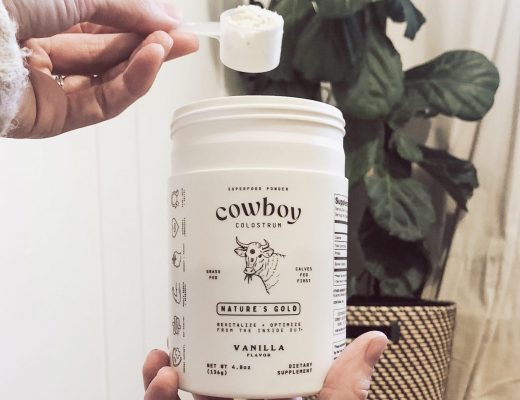
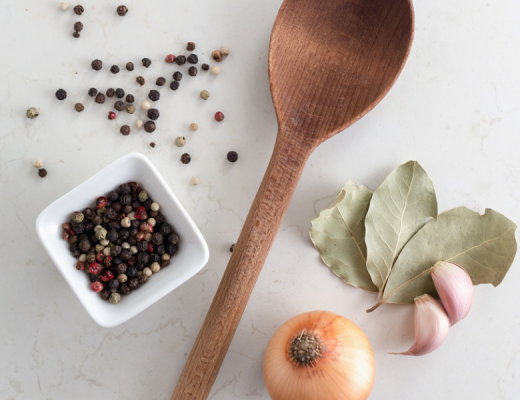
No Comments